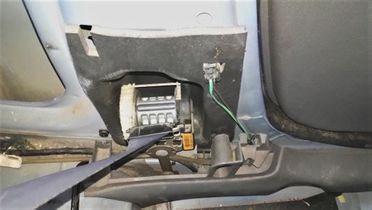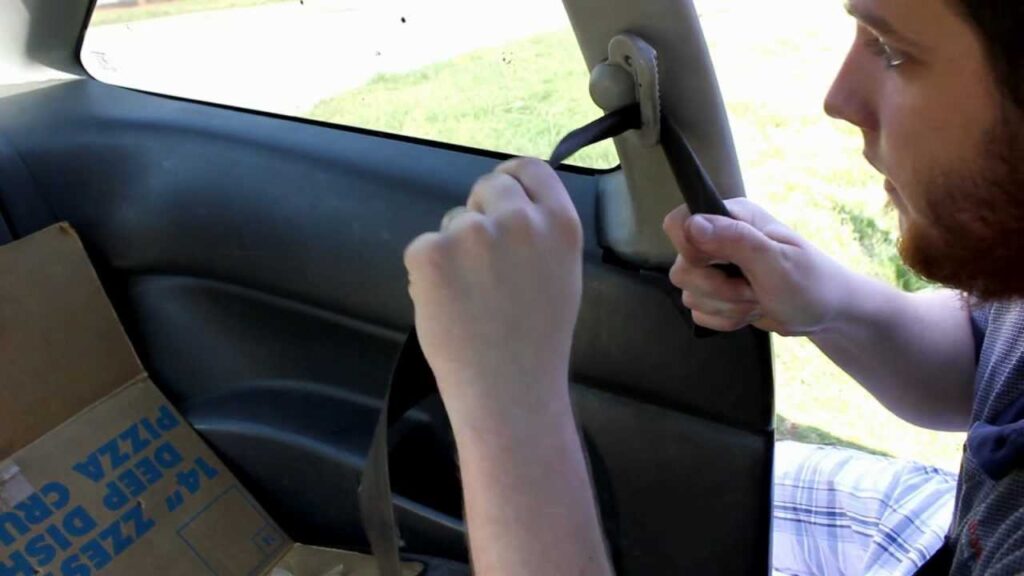Last updated on December 29th, 2022 at 11:43 pm
A seat belt retractor is an essential safety feature in any vehicle, designed to keep you secure in the event of a collision or sudden stop. However, like any mechanical component, seat belt retractors can malfunction or break over time. In this guide we will talk about the various reasons why seat belt retractors stop functioning properly and how to fix a seat belt retractor?
Whether you are a car enthusiast or simply want to save some money on repairs, this ultimate guide will give you the knowledge and confidence to fix your seat belt retractor on your own.
What Is a Seat Belt Retractor?
A seat belt retractor is a mechanical device that is used to hold the seat belt in place when it is not in use, and to automatically retract the seat belt when it is pulled out to be worn.
It is an important safety feature that helps to keep you secure in your vehicle in the event of a collision or sudden stop. The seat belt retractor is typically located behind the trim panel of the door or the center console of the vehicle, and is connected to the seat belt webbing through a spool or drum.
It is an essential component of the seat belt system, and it is important to ensure that it is functioning properly at all times.
How Do Seat Belt Retractors Work?
What is the mechanism behind seatbelts? Most people don’t really think about how their seatbelt works and how important it is to have a functional one in their car. Let’s take a closer look at how these life-saving devices function.
Seat belts are equipped with a retractor that locks the belt in place during a collision. The force of the collision causes the toothed ratchet wheel in the retractor to rotate, which engages the teeth on the spool and prevents it from unwinding. This locking mechanism keeps you from being ejected from your seat during an accident.
HOW TO FIX A SEAT BELT RETRACTOR

If your seat belt retractor is not functioning properly, it can be a frustrating and potentially dangerous issue. Here is a step-by-step guide on how to fix a seat belt retractor:
Identify the problem
The first step in fixing a seat belt retractor is to determine what the problem is. Common issues include a seat belt that won’t retract, a seat belt that is stuck, and a seat belt that is locked.
Gather tools and materials
Depending on the issue, you may need a variety of tools and materials to fix your seat belt retractor. Some common tools that you may need include a socket set, a torque wrench, a pry bar, and a drill. You may also need replacement parts such as a new retractor spring or a new seat belt spool.
Remove the trim panel
In order to access the seat belt retractor, you will need to remove the trim panel that covers it. This is typically located behind the door or in the center console of the vehicle. Use a pry bar or a trim panel tool to carefully remove the panel without damaging it.
Inspect the seat belt retractor
Once you have access to the seat belt retractor, take a look at it to see if you can identify the problem. If the seat belt is stuck, you may need to gently rotate the spool to free it up.
If the seat belt is locked, you may need to locate and release the locking mechanism. If the seat belt won’t retract, you may need to replace the retractor spring or the spool.
Replace any faulty parts
If you determine that one or more parts of the seat belt retractor are faulty, you will need to replace them. Once the seat belt is disconnected, you can remove the seat belt retractor from the vehicle. This will typically involve removing mounting bolts or screws, and unplugging any electrical connections.
Carefully remove the faulty parts and install the new ones, making sure to follow the manufacturer’s instructions and torque specifications.
Once the new seat belt retractor is installed, reattach the seat belt webbing to the spool or drum using the mounting bolt or release button. Make sure that the seat belt is properly tensioned and that it moves smoothly.
Reinstall the trim panel
Once you have fixed the seat belt retractor, you can reinstall the trim panel. Make sure that it is properly aligned and secured, and test the seat belt to ensure that it is functioning properly.
It is important to follow all safety precautions when working on your seat belt retractor, including wearing protective eyewear and gloves, and following the manufacturer’s instructions.
If you are uncertain about how to fix your seat belt retractor or if the issue persists after attempting the repair, it is recommended to seek the assistance of a professional mechanic.
How can I tell if my seatbelt retractor is malfunctioning?
There are several signs that your seatbelt retractor may be malfunctioning, including:
- The seatbelt becomes stuck or will not retract properly.
- The seatbelt becomes loose or falls out of the retractor when it is not in use.
- The seatbelt feels tight or is difficult to extend when it is being worn.
- The seatbelt retractor makes a loud noise or feels rough when the seatbelt is being worn or retracted.
If you notice any of these issues, it is recommended to have your seatbelt retractor inspected and repaired as needed.
Why Do Seat Belts Get Stuck?

There are several reasons why a seat belt may get stuck, including:
- Worn or damaged components: The seat belt retractor and spool may become worn or damaged over time, causing the seat belt to become stuck or to not retract properly.
- Debris or foreign objects: If debris or foreign objects such as food or drink get into the seat belt retractor, they can cause the seat belt to become stuck.
- Frozen seat belt: In cold weather, the seat belt may freeze and become stuck. This can be caused by moisture getting into the seat belt retractor and freezing, or by the seat belt itself freezing due to the low temperature.
- Electrical issues: If the seat belt retractor is not receiving power, it may not be able to retract the seat belt properly. This can be caused by a faulty electrical connection or a malfunctioning seat belt switch.
- Incorrect installation: If the seat belt is not installed correctly, it may become stuck or not function properly.
If your seat belt is stuck, you may be able to fix it by gently rotating the spool or by removing any debris that may be causing the issue. If the problem persists, it is recommended to seek the assistance of a professional mechanic.
Tips for Preventing Seat Belt Retractor Issues
Here are some tips for preventing seat belt retractor issues:
- Keep the seat belt clean: Debris or foreign objects that get into the seat belt retractor can cause the seat belt to become stuck or to not function properly. To prevent this, keep the seat belt clean and free of debris.
- Avoid overextending the seat belt: When wearing the seat belt, make sure that it is not overextended or stretched too far. This can cause wear and damage to the seat belt retractor, and may cause the seat belt to become stuck.
- Avoid exposing the seat belt to extreme temperatures: Extreme temperatures can cause the seat belt to become stuck or to not function properly. To prevent this, avoid leaving the seat belt in direct sunlight or in very cold environments for extended periods of time.
- Regularly inspect the seat belt retractor: To catch any issues before they become serious, regularly inspect the seat belt retractor for any signs of wear or damage. If you notice any issues, have them repaired as soon as possible.
- Follow the manufacturer’s maintenance recommendations: To ensure that your seat belt retractor is functioning properly, follow the manufacturer’s maintenance recommendations. This may include replacing the seat belt retractor at certain intervals or performing regular inspections.
By following these tips, you can help to prevent seat belt retractor issues and ensure that your seat belt is always ready to keep you safe
FAQS
Below are some frequently asked questions about seatbelt retractors. If you have any further questions, feel free to contact us and we’ll be happy to help.
Q: What is the lifespan of a seatbelt retractor?
A: The lifespan of a seatbelt retractor depends on various factors such as the type of retractor, the quality of the retractor, and the usage of the seatbelt. In general, seatbelt retractors have a lifespan of around 10 years or more. However, it is important to regularly inspect the seatbelt retractor and to replace it if it becomes worn or damaged
Q: Can seatbelt retractors be repaired?
A: In many cases, seatbelt retractors can be repaired if they are not functioning properly. Common problems that can be repaired include a seatbelt that won’t retract, a seatbelt that is stuck, and a seatbelt that is locked. However, if the seatbelt retractor is severely damaged or worn, it may need to be replaced.
Q: Can you drive with a broken seatbelt retractor?
A: No, it is not safe to drive with a broken seatbelt retractor. A seatbelt retractor is an essential safety feature that is designed to keep you secure in the event of a collision or sudden stop. If the seatbelt retractor is not functioning properly, it cannot perform this important safety function, and it is not safe to drive the vehicle.
Q: What are the benefits of having a seatbelt retractor?
A: The benefits of having a seatbelt retractor are many. First, it helps to keep the seatbelt from becoming tangled or twisted, which can be a major annoyance, especially when you’re trying to get out of the car in a hurry.
Additionally, it can help to reduce wear on the seatbelt itself, as well as on your clothing, which can prolong the life of both.
Finally, it can provide a bit of extra comfort by allowing the seatbelt to retract smoothly and evenly, rather than jerking abruptly when it reaches its limit.
CONCLUSION
If you have a seat belt that is stuck, it can be a real pain. If you find yourself in this situation, you may wonder what to do. This blog post has all of the information you need to fix your seat belt retractor. We hope this is helpful to you, and if you have any questions, please contact _.
FOLLOW US
